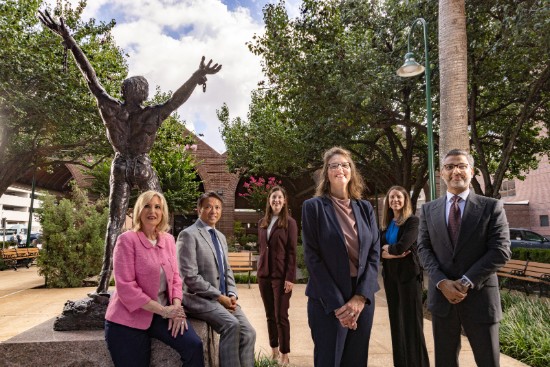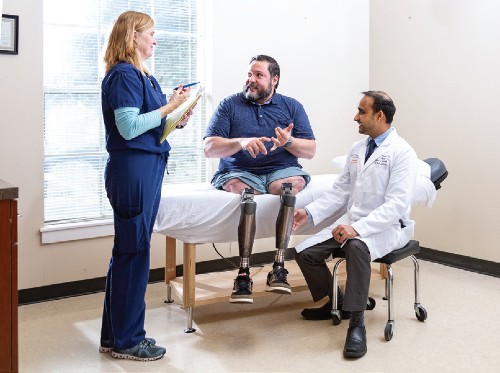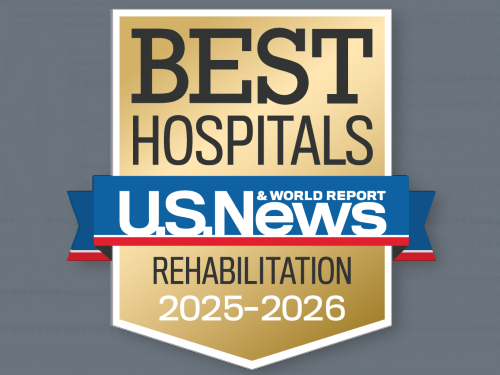 Over the course of its nearly 70-year history, TIRR Memorial Hermann has sought to continuously evolve to meet patient needs.
Over the course of its nearly 70-year history, TIRR Memorial Hermann has sought to continuously evolve to meet patient needs.
TIRR Memorial Hermann Senior Vice President and CEO Rhonda Abbott, PT, FACHE, says, “We are constantly asking ourselves, ‘Where do we need to be to meet the needs of our patients and their families?’”
With TIRR Memorial Hermann planning to continue its evolution in 2025 and beyond, the TIRR Journal is taking a look at where the hospital and its rehabilitation network is now, and where it hopes to be in the years ahead.
TIRR Memorial Hermann is honored to be recognized at the #2 rehabilitation hospital in the country by U.S. News & World report in 2025-2026. With this recognition, TIRR Memorial Hermann believes it has an obligation to lead the rehabilitation field into the future.
With that in mind, TIRR Memorial Hermann leadership is striving to redefine rehabilitation and to revolutionize how rehabilitation medicine services are provided—and in some cases, what is included.
TIRR Memorial Hermann is focusing on a holistic approach to care that prioritizes the health and wellness of patients and their families. Our goal is to make sure patients feel safe and happy, and that they have truly benefited from the services we provide.
A Learning Health System
The concept of a Learning Health System (LHS), first introduced in the mid-2000s, has become increasingly relevant due to advances in big data, machine learning and artificial intelligence (AI). These technologies allow hospitals to systematically integrate internal data with external evidence and then transform that knowledge into actionable initiatives. As a result, health care organizations can deliver higher quality, safer and more efficient care while also becoming better places to work.
Being an LHS requires two interconnected layers of data: internal data generated within the organization and external data from international research and health care systems. Together, they create a continuous loop of learning and improvement.
TIRR Memorial Hermann is leading the charge in transforming health care through the development of an LHS, leveraging the power of big data, machine learning and AI to refine clinical practices and improve patient outcomes. By creating a seamless cycle of evaluation, learning and action, TIRR Memorial Hermann aims to establish itself as a benchmark for what rehabilitation systems can achieve.
However, while that’s the formal definition of an LHS, TIRR Memorial Hermann intends to continue its extensive self-education across care services and teams as well.
“Research is elemental to that, and we want to integrate what we learn from our expanding research programs into clinical interventions that yield better outcomes for our patients and better life experiences for the broad community of people with disabilities,” Abbott explains. “We also want to learn from the data we’re generating on a daily basis to improve key metrics such as patient outcomes, patient and staff safety, and discharge and readmission rates. Our goal is truly to learn how to make tomorrow better than today.”

More Locations, More Care
The second key component of TIRR Memorial Hermann’s current strategic plan involves future expansion of its footprint. Last fall, TIRR Memorial Hermann announced that it had expanded its brand of exceptional rehabilitation care to the southwest area of Houston, via the reorganization of the inpatient medical rehabilitation unit, now known as TIRR Memorial Hermann - Southwest at Memorial Hermann Southwest Hospital. The newly enhanced rehabilitation unit at the hospital now includes 18 private patient rooms; an expanded Family Resource Center; two newly renovated therapy gyms that include gait and balance systems; electrical stimulation to simulate functional, task-specific movements; and a vehicle simulator with true-to-life components designed to provide a safe and convenient alternative to “parking lot” car transfers training for patients with mobility conditions, as well as other additions.
More recently, TIRR Memorial Hermann has announced two new locations opening Fall 2025: TIRR Memorial Hermann Pediatric Outpatient Rehabilitation - Katy, and TIRR Memorial Hermann Outpatient Rehabilitation - Cypress. Further expansion plans involving TIRR Memorial Hermann in the Texas Medical Center are also in the works.
“These improvements will expand our patient capacity and allow us to add additional patient services,” Abbott notes. “We also plan to transition some of our units from semi-private to private patient rooms and are taking other steps to enhance the experience for patients and their families. One thing will remain consistent as we expand: The unique culture we have created at TIRR Memorial Hermann is at the heart of who we truly are, and we want that culture to thrive across all of our facilities and locations, including our connection to the community.”
Accessibility, Expanded
This expansion will also help TIRR Memorial Hermann reinforce a key component of its culture and address the third key component of its strategic plan, which is seeking to ensure that rehabilitation medicine services are accessible to all patients who need them.
“We are constantly evaluating mechanisms to make all patients and their families feel more welcome, that we offer a safe place to receive quality care,” Abbott notes. “And since our founding, we have partnered with community organizations throughout the Houston area to help our patients with disabilities continue their lives after treatment and become a part of their local communities again. This is so fundamental to what we do, and we truly believe TIRR Memorial Hermann and, really, the city of Houston, can serve as a road map for others seeking to achieve the same things.”
Leadership Guiding the Way
Of course, patient care—both inside and outside of the hospital setting—remains central to TIRR Memorial Hermann’s mission, but how that care is delivered must also continue to evolve to meet patient needs.
In an effort to ensure that TIRR Memorial Hermann remains at the forefront of the field of rehabilitation medicine, new leadership has been added to the organization in recent years to foster development and growth in several areas, including clinical research.
“The infusion of new talent and ideas is critical to our success,” says Abbott, who began her current role over four years ago. “TIRR Memorial Hermann has a strong legacy of leading the field, and we’re standing on the shoulders of those leaders who created that. But we’re also building on that legacy, looking to create new solutions for our patients. It’s an exciting time.”
 One of those relatively new leaders is Farhaan S. Vahidy, PhD, MBBS, MPH, FAHA, who was named vice president for research and the chief scientific officer in 2023. Since his arrival at TIRR Memorial Hermann, Dr. Vahidy has led a wide range of research programs, big data enterprises and quality-of-care initiatives focused on neurologic diseases such as stroke, brain hemorrhage, cerebrovascular diseases, Parkinson’s disease and multiple sclerosis.
One of those relatively new leaders is Farhaan S. Vahidy, PhD, MBBS, MPH, FAHA, who was named vice president for research and the chief scientific officer in 2023. Since his arrival at TIRR Memorial Hermann, Dr. Vahidy has led a wide range of research programs, big data enterprises and quality-of-care initiatives focused on neurologic diseases such as stroke, brain hemorrhage, cerebrovascular diseases, Parkinson’s disease and multiple sclerosis.
Another relatively new addition to the team is the director of the Amputee and Limb Loss Rehabilitation Program, Vinay Vanodia, MD. Among other initiatives, Dr. Vanodia has spearheaded TIRR Memorial Hermann’s rehabilitation integration with osseointegration, a procedure that creates a direct structural and functional connection between living bone and the surface of a load-bearing artificial implant.
Dr. Vanodia came to TIRR Memorial Hermann in 2022, in what was then a newly created limb loss fellowship program. “Dr. Vanodia is bringing our limb loss program to new heights, in particular through the use of osseointegration,” Dr. Francisco notes.
 Dr. Vanodia, along with Limb Loss program, Kristin Reeves, PT, published “A Goal-Directed Rehabilitation Protocol for People with Transfemoral Amputation Receiving Osseointegrations Prostheses” in the Physical Medicine & Rehabilitation Journal. As one of the first civilian-focused, multidisciplinary rehab protocols in the United States for osseointegration (OI) since FDA approval in December 2020, this work represents a major step forward in advancing care for people with limb loss. Since the original Walter Reed protocol did not align with civilian insurance models, our team developed a goal-directed, comprehensive pathway for patients and doctors to follow, from surgery through rehabilitation, to meet those needs.
Dr. Vanodia, along with Limb Loss program, Kristin Reeves, PT, published “A Goal-Directed Rehabilitation Protocol for People with Transfemoral Amputation Receiving Osseointegrations Prostheses” in the Physical Medicine & Rehabilitation Journal. As one of the first civilian-focused, multidisciplinary rehab protocols in the United States for osseointegration (OI) since FDA approval in December 2020, this work represents a major step forward in advancing care for people with limb loss. Since the original Walter Reed protocol did not align with civilian insurance models, our team developed a goal-directed, comprehensive pathway for patients and doctors to follow, from surgery through rehabilitation, to meet those needs.
TIRR Memorial Hermann is among the few organizations nationally offering this treatment to patients who have experienced limb loss, and we have cared for more than 35 patients through this program.
Meanwhile, although TIRR Memorial Hermann isn’t the only rehabilitation hospital nationally caring for patients with neurobehavioral disorders as a result of brain injury, our program certainly is unique. Under the leadership of Christopher M. Falco, MD, and Lindsey Harik, PhD, it is one of the few programs that strive to minimize the use of sedative medication to promote achievement of optimal cognitive function levels earlier in patient recovery. The Neurobehavioral Program, established in 2015, includes a full staff of rehabilitation medicine specialists, psychologists and neuropsychologists, speech language pathologists, care team coordinators, physical and occupational therapists, nurses, nurse aides, and technicians—all of whom are experienced and trained in caring for patients with these often complex disorders.
“Many brain injury programs treat patients with neurobehavioral disorders, but not everyone has the same focus and the true emphasis on patient recovery,” Dr. Francisco says. “Yes, we want a safe environment for staff and patients, but we also want patients to get better.”
Similarly, the Disorders of Consciousness (DoC) Program at TIRR Memorial Hermann provides state-of-the-art care for patients in unresponsive wakefulness or minimally conscious states. Disorders of consciousness can arise from a variety of brain injuries, including traumatic brain injuries and injuries due to hypoxia, stroke or aneurysm rupture. The DoC program at TIRR Memorial Hermann admits and treats patients regardless of the etiology of their injury and is the only such program in the country that admits patients who are on ventilators, thanks to a respiratory therapy team that is available 24/7.
“A lot of centers won’t take patients with brain injuries or stroke who are on ventilators because of the complexity of care involved,” says Gerard Francisco, MD, Chief Medical Officer. “The thinking is that many of these patients are not able to participate in meaningful rehabilitation while they’re being weaned off the ventilator. But we think differently. We believe that the earlier you can initiate rehabilitative care, the more you may be able to influence the recovery.”
Key Metrics

TIRR Memorial Hermann treats nearly 1,600 patients annually including more than 300 inpatients and a significant number of outpatients for spinal cord injury.
Notably, in keeping with TIRR Memorial Hermann’s focus on reintegrating patients into their communities as quickly as possible, the health system boasts a discharge-to-community rate of 73%, meaning that 73% of patients are discharged back home or to a community setting after completing their rehabilitation.
It is numbers such as these that brought TIRR Memorial Hermann recognition as one of the leading rehabilitation hospitals in the United States. Indeed, the health system is one of only 14 sites nationally designated as a Traumatic Brain Injury Model System by the National Institute on Disability and Rehabilitation Research. The health system has also been accredited by the Commission on Accreditation of Rehabilitation Facilities (CARF), which signals our commitment to continually improving services, encouraging feedback and serving the community. Every year since 1990, TIRR Memorial Hermann has appeared on the list of America’s “Best Hospitals for Rehabilitation,” published by U.S. News & World Report, ranking No. 2 again in 2025.
In addition, TIRR Memorial Hermann has been designated as a National Rehabilitation Innovation Center as a result of legislation passed by Congress and signed into law by President Joe Biden on Jan. 5, 2023. The Dr. Joanne Smith Memorial Rehabilitation Innovation Centers Act of 2022 recognizes a leading class of pioneering rehabilitation research facilities across the country, including TIRR Memorial Hermann, that set the standard for ongoing study and patient care.
